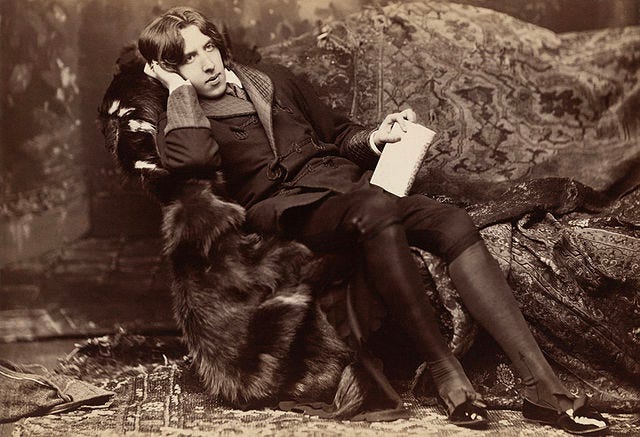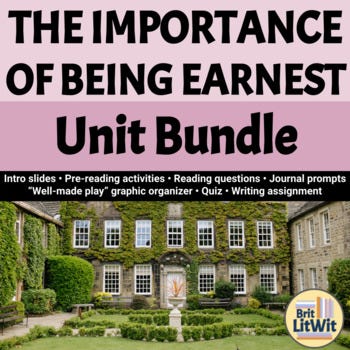The challenges of teaching "Earnest" (and how to overcome them!)
When I was a high school senior a zillion years ago, I chose The Importance of Being Earnest by Oscar Wilde for one of my independent reading assignments. I was charmed by all the witty lines and how the plot came together, so I figured it would be a great text to write about for one of the essays on the AP English exam. And it worked out; my score was a 4 out of 5—good enough! But I still wondered why I didn’t get a top score because English class was my thing. (And I already knew then that I was going to be an English teacher.) Several college literature courses later, I realized I probably could have aced that exam if I had analyzed something meatier, like Heart of Darkness or Mrs. Dalloway. Anything but a lighthearted comedy would have served me better.
Nevertheless, I still love The Importance of Being Earnest. It’s a work of genius, but in the way a Seinfeld episode is, with the perfect timing, coincidences, and one-liners. It’s entertaining, but it doesn’t fit in that well with the rest of the high school English curriculum because it’s pretty lean on theme and character development. It just doesn’t lend itself as easily to a unit of study (or AP exam essay) as something like a Shakespeare play does.
So of course, the first time I taught Earnest was a snoozefest (due in part to the dry educational publisher materials that were the only thing available back in 2009, but we don’t have to get into all that)! Over the years I figured out how to deal with the sticking points of teaching this play, so I hope the following ideas help you as you prepare your unit.
Earnest problem #1: The Victorian setting seems stuffy and unrelatable to today’s students.
Solution: Use Oscar Wilde’s satire of the Victorian era to launch a discussion about which customs from our own time deserve to be ridiculed. Let students know that Wilde wasn’t romanticizing the lives of wealthy Victorians à la a BBC costume drama. Rather, he was writing about the goofy ways wealthy Victorians tried to keep up appearances. When I started framing Earnest this way, students were eager to hunt for the silly behavior in the play and find parallels in our own time within situations like social media posts, dating, and the college application process. Use my Victorian Etiquette Quiz to get students interested at the start of the unit. Finish your unit with a scaffolded writing assignment that requires students to identify the targets of Wilde’s satire and examine whether society has changed.
Earnest problem #2: The dated jokes and tricky banter can make it torturous to read the play aloud.
Solution: Still read the play in class so you can explain the important points, but break it up with movie clips. The 2002 film starring Reese Witherspoon, Judi Dench, Colin Firth, and Rupert Everett reinforces the cause and effect in the plot, makes the jokes more obvious, and helps students develop a sense of how each character’s lines should be delivered based on their personalities. Trust me: your students will appreciate this play so much more if they see at least some parts of the movie.
Earnest problem #3: It’s difficult for students to differentiate between the characters (and therefore they struggle to follow the plot).
Solution: Provide a character map that details characters’ relationships (and motivations). When I first started teaching, I used to worry that a resource like that would give away the plot, but I promise your students will not study it before you start reading or feel cheated in some way. I include a character map in my intro slides just to set the expectation that the events in the play will be complicated. It becomes more useful later to point out character connections as they pop up.
Earnest problem #4: The play is so short that it seems impossible to make a unit out of it.
Solution: Keep your study of Earnest succinct. That’s right, just do less. Even though Earnest is a play, you don’t need to plan a unit that resembles what you do for Macbeth or Hamlet. It only takes about three 50-minute class periods to read Earnest, so don’t try to use it to teach every aspect of literary analysis. Just focus on the main thing that matters: how the satire of a bygone era still resonates today. Don’t string out the reading for too long or pile on the worksheets with this text because it’ll feel like busywork. I always felt like my Earnest unit worked best when we spent 6-8 class periods on it!
The Importance of Being Earnest is a beloved play, but it can be daunting to teach for the first time because it doesn’t feel like a typical English class text. Simplify your planning with my unit bundle for The Importance of Being Earnest. It includes a pacing guide, intro activities and informative slides, reading questions, a quiz, a writing assignment, and fun extras!





